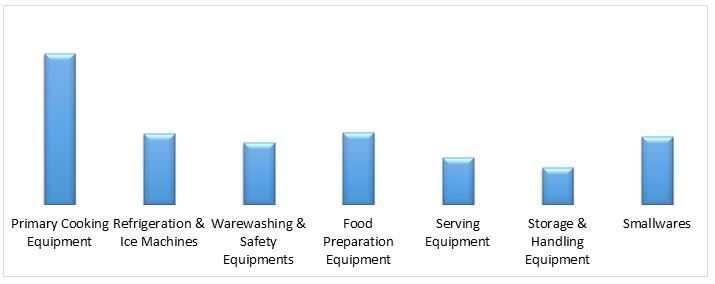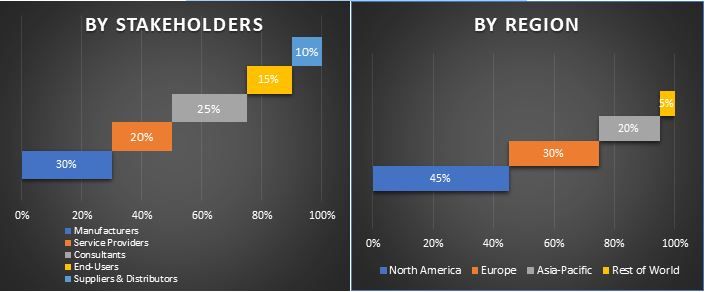- Startseite
- Über uns
- Industrie
- Dienstleistungen
- Lesen
- Kontaktieren Sie uns
Markt für Gastronomieausrüstung: Aktuelle Analyse und Prognose (2021-2027)
Schwerpunkt auf Gerätetyp (Koch- & Zubereitungsgeräte, Kühlgeräte, Geschirrspülgeräte, Lager- & Fördertechnik, Sonstige); Vertriebskanal (Online, Offline); Endverbraucher (Restaurants mit Bedienung, Schnellrestaurants, Hotels & Pubs/Bars/Clubs, Sonstige); und Region & Land

Geräte wie Koch-, Spül-, Lager- und Handhabungsgeräte werden in der Gastronomie für die Zubereitung und Lagerung von Lebensmitteln für kommerzielle Zwecke eingesetzt. Aufgrund des signifikanten Wachstums im Gastgewerbe und der vermehrten Verwendung von temperaturoptimierten Lagergeräten für verderbliche Lebensmittel steigt der Bedarf an Gastronomieausstattung weltweit. Die gestiegenen Pro-Kopf-Ausgaben der Verbraucher für Lebensmittel haben sie zu Online-Lebensmittelbestellungen und Restaurantbesuchen veranlasst. Beispielsweise hat Japan mit 4.417,5 USD pro Person die höchsten Pro-Kopf-Ausgaben für Lebensmittel, gefolgt von Australien, Kanada und Frankreich mit Ausgaben von 3.003,6 USD, 2.986,9 USD bzw. 2.983,4 USD pro Person. Dies hat zu einer Nachfrage nach Gastronomieausstattung in Restaurants, Cafés und Hotels geführt.
Die Anzahl der Hotels wächst weiterhin, wenn auch in einem moderaten Tempo. Die Gesamtzahl der Hotels weltweit erreichte im Jahr 2018 184.299, wobei seit 2008 14.252 Hotels hinzugekommen sind. Diese Zahl steigt kontinuierlich mit der steigenden Nachfrage nach Fertiggerichten. Mit dem deutlichen Anstieg der Gesamtzahl der Hotels weltweit steigt auch die Nachfrage nach der Installation von Gastronomieausstattung wie Kochgeräten, Kühlschränken, Lagergeräten und anderen derartigen Geräten, was den Markt in den kommenden Jahren voraussichtlich ankurbeln wird. Darüber hinaus hat sich mit der Zunahme der Erwerbsbevölkerung auch die Nachfrage nach Fertiggerichten entsprechend erhöht. Dies hat auch die Nachfrage nach Full-Service-Restaurants (FSR) und Quick-Service-Restaurants (QSR) angekurbelt. Beispielsweise liegen laut der Organisation für wirtschaftliche Zusammenarbeit und Entwicklung in Ländern wie Japan, den USA, Kanada und Großbritannien die Beschäftigungsquoten von Frauen bei 67,5 %, 64,9 %, 70,6 % bzw. 69,7 %.
KOSTENLOSES MUSTER ALS PDF ANFORDERN
Der Anstieg der Beschäftigungsquote zusammen mit dem gestiegenen Konsum von Fertiggerichten treibt den Markt für Full-Service-Restaurants an.
Weltweites Budget für Gastronomieausstattung, 2018
Welbilt, The Middleby Corporation, Standex International Corporation, ITW Food Equipment Group, Dover Corporation, Haier Inc., AB Electrolux, The Manitowoc Company, Inc., Ali Group S.R.L und Duke Manufacturing usw. sind einige der prominenten Akteure auf dem globalen Markt für Gastronomieausstattung. Mehrere Fusionen und Übernahmen sowie Partnerschaften wurden von diesen Akteuren eingegangen, um Kunden mit Hightech- und innovativen Produkten zu versorgen.
Im Bericht dargestellte Erkenntnisse
„Unter den Gerätetypen hält das Segment Kochen & Zubereiten den größten Anteil“
Basierend auf dem Gerätetyp ist der Markt in Koch- & Zubereitungsgeräte, Kühlgeräte, Geschirrspülgeräte, Lager- & Handhabungsgeräte und Sonstige unterteilt. Das Segment Kochen & Zubereiten dominierte den Markt mit einem Anteil von XX % im Jahr 2020 und wird seine Dominanz im Prognosezeitraum voraussichtlich beibehalten, was auf die Nachfrage für alle Arten von Restaurants, Hotels usw. zurückzuführen ist.
„Unter den Vertriebskanälen wird erwartet, dass Offline im analysierten Zeitraum die höchste CAGR verzeichnen wird“
Basierend auf dem Vertriebskanal ist der Markt in Online und Offline unterteilt. Im Jahr 2020 machte Offline einen maximalen Marktumsatzanteil von XX % aus und wird im analysierten Zeitraum voraussichtlich weiterhin dominant bleiben. Durch Offline-Käufe können Endbenutzer die technischen Spezifikationen und die Funktionsweise des Produkts leicht analysieren, weshalb das Offline-Segment im Prognosezeitraum voraussichtlich die höchste CAGR verzeichnen und eine Marktbewertung von XX Milliarden USD erreichen wird.
Unter den Endbenutzern hält das Segment Full-Service-Restaurant den größten Anteil“
Basierend auf den Endbenutzern ist der Markt in Full-Service-Restaurants, Quick-Service-Restaurants, Hotels & Pub-Bar-Clubs und Sonstige unterteilt. Die Full-Service-Restaurants dominierten den Markt im Jahr 2020 mit einem Umsatz von XX Milliarden USD und werden ihre Dominanz im analysierten Zeitraum voraussichtlich beibehalten.
„Nordamerika stellt einen der größten Märkte für Gastronomieausstattung dar“
Für ein besseres Verständnis der Marktdynamik des Marktes für Gastronomieausstattung wurde eine detaillierte Analyse für verschiedene Regionen auf der ganzen Welt durchgeführt, darunter Nordamerika (Vereinigte Staaten, Kanada und das übrige Nordamerika), Europa (Deutschland, Frankreich, Italien, Spanien, Vereinigtes Königreich und das übrige Europa), Asien-Pazifik (China, Japan, Indien, Australien und das übrige APAC) und der Rest der Welt. Aufgrund der zunehmenden Akzeptanz von technologisch fortschrittlichen Geräten dominierte Nordamerika den Markt und erwirtschaftete im Jahr 2020 einen Umsatz von XX Milliarden USD.
Gründe für den Kauf dieses Berichts:
- Die Studie umfasst eine Marktdimensionierungs- und Prognoseanalyse, die von authentifizierten wichtigen Branchenexperten validiert wurde
- Der Bericht bietet einen schnellen Überblick über die Gesamtleistung der Branche auf einen Blick
- Der Bericht enthält eine detaillierte Analyse prominenter Branchenkollegen mit einem primären Fokus auf wichtige Finanzdaten, Produktportfolio, Expansionsstrategien und aktuelle Entwicklungen
- Detaillierte Untersuchung der Treiber, Einschränkungen, wichtigsten Trends und Chancen, die in der Branche vorherrschen
- Die Studie deckt den Markt umfassend über verschiedene Segmente hinweg ab
- Tiefgehende regionale Analyse der Branche
Anpassungsoptionen:
Der Markt für Gastronomieausstattung kann je nach Anforderung oder einem anderen Marktsegment weiter angepasst werden. Darüber hinaus versteht UMI, dass Sie möglicherweise Ihre eigenen geschäftlichen Anforderungen haben. Zögern Sie daher nicht, sich mit uns in Verbindung zu setzen, um einen Bericht zu erhalten, der Ihren Anforderungen vollständig entspricht.
Inhaltsverzeichnis
Die Analyse des historischen Marktes, die Schätzung des aktuellen Marktes und die Prognose des zukünftigen Marktes für den globalen Markt für Gastronomieausrüstung waren die drei wichtigsten Schritte, die unternommen wurden, um die Einführung von Gastronomieausrüstung für die verschiedenen Zwecke in den wichtigsten Regionen weltweit zu erstellen und zu analysieren. Es wurden umfassende Sekundärrecherchen durchgeführt, um die historischen Marktzahlen zu sammeln und die aktuelle Marktgröße zu schätzen. Zweitens wurden zahlreiche Erkenntnisse und Annahmen berücksichtigt, um diese Erkenntnisse zu validieren. Darüber hinaus wurden umfassende Primärinterviews mit Branchenexperten entlang der Wertschöpfungskette des Gastronomieausrüstungssektors geführt. Nach der Annahme und Validierung der Marktzahlen durch Primärinterviews wendeten wir einen Top-Down/Bottom-Up-Ansatz an, um die vollständige Marktgröße vorherzusagen. Danach wurden Methoden zur Marktzerlegung und Datentriangulation angewendet, um die Marktgröße von Segmenten und Untersegmenten der Branche zu schätzen und zu analysieren. Die detaillierte Methodik wird im Folgenden erläutert:
Analyse der historischen Marktgröße
Schritt 1: Eingehende Untersuchung sekundärer Quellen:
Es wurde eine detaillierte Sekundärstudie durchgeführt, um die historische Marktgröße der Gastronomieausrüstung aus unternehmensinternen Quellen wie Jahresberichte und Finanzberichte, Performance-Präsentationen, Pressemitteilungen usw. und externen Quellen wie Fachzeitschriften, Nachrichten und Artikel, Regierungsveröffentlichungen, Wettbewerberveröffentlichungen, Sektorberichte, Datenbanken von Drittanbietern und andere glaubwürdige Veröffentlichungen zu erhalten.
Schritt 2: Marktsegmentierung:
Nachdem wir die historische Marktgröße der Gastronomieausrüstung erhalten hatten, führten wir eine detaillierte Sekundäranalyse durch, um historische Markteinblicke und Anteile für verschiedene Segmente für die wichtigsten Regionen zu sammeln. Zu den wichtigsten Segmenten, die im Bericht enthalten sind, gehören Gerätetyp, Vertriebskanal und Endverbraucher. Weitere Analysen auf Länderebene wurden durchgeführt, um die allgemeine Akzeptanz von Gastronomieausrüstung in jeder Region zu bewerten.
Schritt 3: Faktorenanalyse:
Nachdem wir die historische Marktgröße verschiedener Segmente und Untersegmente ermittelt hatten, führten wir eine detaillierte Faktorenanalyse durch, um die aktuelle Marktgröße von Gastronomieausrüstung zu schätzen. Darüber hinaus führten wir eine Faktorenanalyse unter Verwendung abhängiger und unabhängiger Variablen durch, wie z. B. die steigende Nachfrage nach Fertiggerichten in der Bevölkerung. Eine gründliche Analyse wurde für Nachfrage- und Angebotsseitenszenarien unter Berücksichtigung von Top-Partnerschaften, Fusionen und Übernahmen, Geschäftsausweitungen und Produkteinführungen in der Gastronomieausrüstungsindustrie auf der ganzen Welt durchgeführt.
Aktuelle Marktzufallsschätzung und Prognose
Aktuelle Marktgröße: Basierend auf den umsetzbaren Erkenntnissen aus den oben genannten 3 Schritten haben wir die aktuelle Marktgröße, die wichtigsten Akteure auf dem Markt für Gastronomieausrüstung und die Marktanteile der Segmente ermittelt. Alle erforderlichen prozentualen Anteile und Marktaufschlüsselungen wurden mithilfe des oben genannten sekundären Ansatzes ermittelt und durch Primärinterviews verifiziert.
Schätzung & Prognose: Für die Marktschätzung und -prognose wurden verschiedenen Faktoren Gewichte zugewiesen, darunter Treiber und Trends, Beschränkungen und Chancen, die den Stakeholdern zur Verfügung stehen. Nach der Analyse dieser Faktoren wurden relevante Prognosetechniken, d. h. der Top-Down/Bottom-Up-Ansatz, angewendet, um die Marktprognose bis etwa 2027 für verschiedene Segmente und Untersegmente in den wichtigsten Märkten weltweit zu erstellen. Die Forschungsmethodik zur Schätzung der Marktgröße umfasst:
- Die Marktgröße der Branche in Bezug auf den Wert (USD) und die Akzeptanzrate von Gastronomieausrüstung in den wichtigsten Märkten im Inland
- Alle prozentualen Anteile, Aufteilungen und Aufschlüsselungen von Marktsegmenten und Untersegmenten
- Die wichtigsten Akteure auf dem Markt für Gastronomieausrüstung in Bezug auf die angebotenen Dienstleistungen. Außerdem die von diesen Akteuren angewandten Wachstumsstrategien, um im schnell wachsenden Markt zu bestehen
Validierung von Marktgröße und -anteil
Primärforschung: Es wurden ausführliche Interviews mit den wichtigsten Meinungsführern (Key Opinion Leaders, KOLs) geführt, darunter Führungskräfte der obersten Ebene (CXO/VPs, Vertriebsleiter, Marketingleiter, Betriebsleiter und Regionalleiter, Landesleiter usw.) in den wichtigsten Regionen. Die Ergebnisse der Primärforschung wurden dann zusammengefasst und eine statistische Analyse durchgeführt, um die aufgestellte Hypothese zu beweisen. Die Erkenntnisse aus der Primärforschung wurden mit den sekundären Erkenntnissen zusammengeführt, wodurch Informationen in umsetzbare Erkenntnisse umgewandelt wurden.
Aufteilung der primären Teilnehmer in verschiedene Regionen
Markt Engineering
Die Datentriangulationstechnik wurde angewendet, um die allgemeine Marktschätzung abzuschließen und präzise statistische Zahlen für jedes Segment und Untersegment des Marktes für Gastronomieausrüstung zu erhalten. Die Daten wurden in mehrere Segmente und Untersegmente aufgeteilt, nachdem verschiedene Parameter und Trends in den Bereichen Gerätetyp, Vertriebskanal und Endverbraucher des Marktes für Gastronomieausrüstung untersucht wurden.
Hauptziel der Marktstudie für Gastronomieausrüstung
Die aktuellen und zukünftigen Markttrends für Gastronomieausrüstung wurden in der Studie genau bestimmt. Investoren können strategische Einblicke gewinnen, um ihre Diskretion für Investitionen auf der Grundlage der in der Studie durchgeführten qualitativen und quantitativen Analyse zu untermauern. Aktuelle und zukünftige Markttrends bestimmten die allgemeine Attraktivität des Marktes auf regionaler Ebene und boten den Industrieteilnehmern eine Plattform, um den unerschlossenen Markt zu nutzen und von einem First-Mover-Vorteil zu profitieren. Weitere quantitative Ziele der Studien umfassen:
- Analyse der aktuellen und prognostizierten Marktgröße von Gastronomieausrüstung in Bezug auf den Wert (USD). Analysieren Sie auch die aktuelle und prognostizierte Marktgröße verschiedener Segmente und Untersegmente
- Zu den Segmenten in der Studie gehören die Bereiche Gerätetyp, Vertriebskanal und Endverbraucher
- Definition und Analyse des regulatorischen Rahmens für die Gastronomieausrüstungsindustrie
- Analyse der Wertschöpfungskette unter Einbeziehung verschiedener Vermittler sowie Analyse des Kunden- und Wettbewerberverhaltens der Branche
- Analyse der aktuellen und prognostizierten Marktgröße des Marktes für Gastronomieausrüstung für die wichtigsten Regionen
- Zu den wichtigsten Regionen, die im Bericht untersucht werden, gehören Nordamerika (die Vereinigten Staaten und Kanada), Europa (Deutschland, Frankreich, Italien, Spanien und das Vereinigte Königreich), der asiatisch-pazifische Raum (China, Japan, Indien und Australien) und der Rest der Welt
- Unternehmensprofile des Marktes für Gastronomieausrüstung und die von den Marktteilnehmern angewandten Wachstumsstrategien, um im schnell wachsenden Markt zu bestehen
- Eingehende regionale Analyse der Branche
Verwandt Berichte
Kunden, die diesen Artikel gekauft haben, kauften auch












